Related Research Articles

The St. Francis Dam, or the San Francisquito Dam, was a concrete gravity dam located in San Francisquito Canyon in northern Los Angeles County, California, United States, that was built between 1924 and 1926. The dam failed catastrophically in 1928, killing at least 431 people in the subsequent flood, in what is considered to have been one of the worst American civil engineering disasters of the 20th century and the third-greatest loss of life in California history.

On Monday, December 1, 1958, a fire broke out at Our Lady of the Angels School in Chicago, Illinois, shortly before classes were to be dismissed for the day. The fire originated in the basement near the foot of a stairway. The elementary school was operated by the Archdiocese of Chicago and had an enrollment of approximately 1600 students. A total of 92 pupils and 3 nuns ultimately died when smoke, heat, fire, and toxic gases cut off their normal means of egress through corridors and stairways. Many more were injured when they jumped from second-floor windows which, because the building had a raised basement, were nearly as high above ground as a third floor would be on level ground, approximately 25 feet (7.6 m).

The Iroquois Theatre fire was a catastrophic building fire in Chicago, Illinois, that broke out on December 30, 1903 during a performance attended by 1,700 people. The fire caused 602 deaths and 250 non-fatal injuries. It ranks as the worst theater fire in the United States, surpassing the carnage of the Brooklyn Theatre fire of 1876, which claimed at least 278 lives.
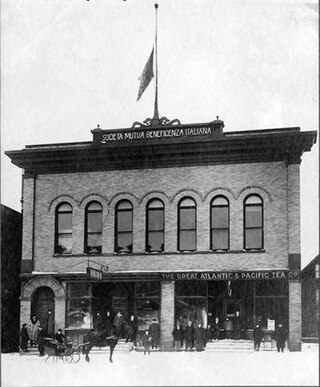
The Italian Hall disaster was a tragedy that occurred on Wednesday, December 24, 1913, in Calumet, Michigan, United States. Seventy-three people – mostly striking mine workers and their families – were crushed to death in a stampede when someone falsely shouted "fire" at a crowded Christmas party.

The Queen Street massacre was a mass shooting which occurred on 8 December 1987 at Australia Post offices on 191 Queen Street in Melbourne, Victoria.

The Garley Building fire took place on 20 November 1996 in the 16-storey Garley commercial building located at 232–240 Nathan Road, Jordan, Hong Kong. The fire caused 41 deaths and 81 injuries. It is considered the worst building fire in Hong Kong during peacetime. The fire damaged the bottom two floors and the top three floors of the building, while the middle floors remained relatively intact.
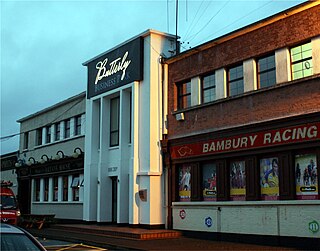
The Stardust fire was a fatal fire which took place at the Stardust nightclub in Artane, Dublin, Ireland, in the early hours of 14 February 1981. More than 800 people were attending a disco there, of whom 48 died and 214 were injured as a result of the fire; in later years suicides of survivors and family members were also linked to the event.
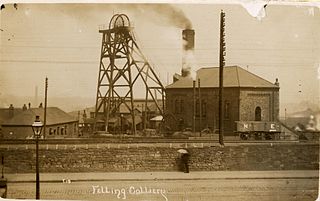
The Felling Colliery in Britain, suffered four disasters in the 19th century, in 1812, 1813, 1821 and 1847. By far the worst of the four was the 1812 disaster which claimed 92 lives on 25 May 1812. The loss of life in the 1812 disaster was one of the motivators for the development of miners' safety lamps such as the Geordie lamp and the Davy lamp.

The Bath School disaster, also known as the Bath School massacre, was a series of violent attacks perpetrated by Andrew Kehoe upon the Bath Consolidated School in Bath Charter Township, Michigan, United States, on May 18, 1927. The attacks killed 38 children and 6 adults, and injured at least 58 other people. Prior to the explosions at the school, Kehoe had murdered his wife, Nellie Price Kehoe, and firebombed his farm. Arriving at the site of the school explosion, Kehoe died when he set off explosives concealed in his truck.
The open verdict is an option open to a coroner's jury at an inquest in the legal system of England and Wales. The verdict means the jury confirms the death is suspicious, but is unable to reach any other verdicts open to them. Mortality studies consider it likely that the majority of open verdicts are recorded in cases of suicide where the intent of the deceased could not be proved, although the verdict is recorded in many other circumstances.
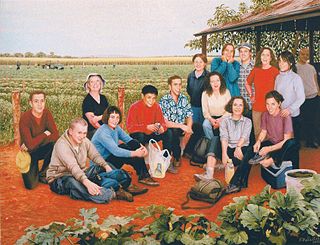
The Childers Palace Backpackers Hostel fire on 23 June 2000 killed 15 backpackers – nine women and six men – at the former Palace Hotel in the town of Childers, Queensland, Australia, which had been converted into a backpacker hostel. Robert Paul Long was arrested for lighting the fire and charged with two counts of murder and one count of arson. He was later sentenced to life imprisonment.

Granite Mills are two historic cotton textile mills located on Bedford Street in Fall River, Massachusetts, consisting of Granite Mill No. 2 and Granite Mill No. 3. The site was determined eligible to be listed on the National Register of Historic Places in 1983, but was omitted due to owner's objection.

The Brooklyn Theatre fire was a catastrophic theatre fire that broke out on the evening of December 5, 1876, in the city of Brooklyn. The fire took place at the Brooklyn Theatre, near the corner of Washington and Johnson streets, with over 1,000 guests attending. The conflagration killed at least 278 individuals, with some accounts reporting more than 300 dead. 103 unidentified victims were interred in a common grave at Green-Wood Cemetery, marked by an obelisk, while more than two dozen identified victims were interred individually in separate sections at the Cemetery of the Evergreens in Brooklyn.

The Penhallow Hotel fire was a suspected arson attack that occurred in Newquay, Cornwall on 18 August 2007. Three people were killed and it was reported as the worst hotel fire in the United Kingdom in nearly 40 years. The hotel was a well-known hotel for holiday makers ranging from families to older residents. It had been built in Island Crescent between 1912 and 1917, and had been altered more than once. The building had a wooden fire escape at the rear, and a central light shaft running from the ground floor up to the roof in the centre of the hotel. Both of these aspects of the building played a dramatic role in the outcome of the fire. Many of those that escaped the fire were elderly holiday makers.
The Top Storey Club was a nightclub in Bolton, Greater Manchester, England. It achieved notoriety for a fire which occurred on 1 May 1961 in which 19 people perished.
Black Sunday has been used to describe January 23, 2005, when three firefighters of the New York City Fire Department (FDNY) died in two fires: two at a tenement fire in the Morris Heights section of the Bronx, with four others being seriously injured, and one at a house fire in the East New York section of Brooklyn. It was the deadliest day for the FDNY since the World Trade Center attack on September 11, 2001, and the first time since 1918 that firefighters had died at two separate incidents on the same day.

On 14 June 2017, a high-rise fire broke out in the 24-storey Grenfell Tower block of flats in North Kensington, West London, at 00:54 BST and burned for 60 hours. Seventy people died at the scene, and two people died later in hospital, with more than 70 injured and 223 escaping. It was the deadliest structural fire in the United Kingdom since the 1988 Piper Alpha oil-platform disaster and the worst UK residential fire since the German Bombings of World War II.

The Arcadia Hotel fire occurred on December 3, 1913 in a flophouse on the corner of Washington and Laconia Streets in Boston's South End. The fire killed 28 persons, making it the deadliest in Boston at that time, passing the Great Boston Fire of 1872.
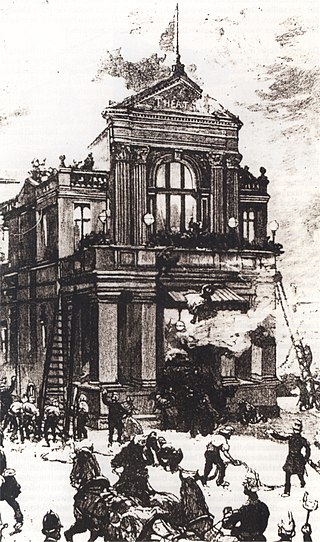
On 5 September 1887, a fire broke out in the backstage area of the Theatre Royal in Exeter, England, during the production of The Romany Rye. The fire caused panic throughout the theatre, with 186 people dying from a combination of the direct effects of smoke and flame, crushing and trampling, and trauma injuries from falling or jumping from the roof and balconies.
References
- ↑ "23 Killed---26 Wounded". The Pilot. September 26, 1874. Retrieved 27 August 2022.
- 1 2 3 4 5 6 "A Complete Review of the Disaster". The New York Times. September 20, 1874.
- 1 2 3 4 5 6 7 "A Shocking Calamity". The New York Times. September 20, 1874.
- 1 2 3 4 5 6 Dion, Marc Munroe (April 14, 2009). "Mill fire sparked workers' rights battle". The Herald News. Retrieved 27 August 2022.
- 1 2 "The Fall River Disaster: The Verdict of the Coroner's Jury". The New York Times. October 4, 1874.
- ↑ "The Fall River Disaster". The Boston Daily Globe. September 21, 1874.
- ↑ "The Fall River Disaster". The New York Times. September 21, 1874.
- ↑ "In Inquest". The Boston Daily Globe. September 22, 1874.